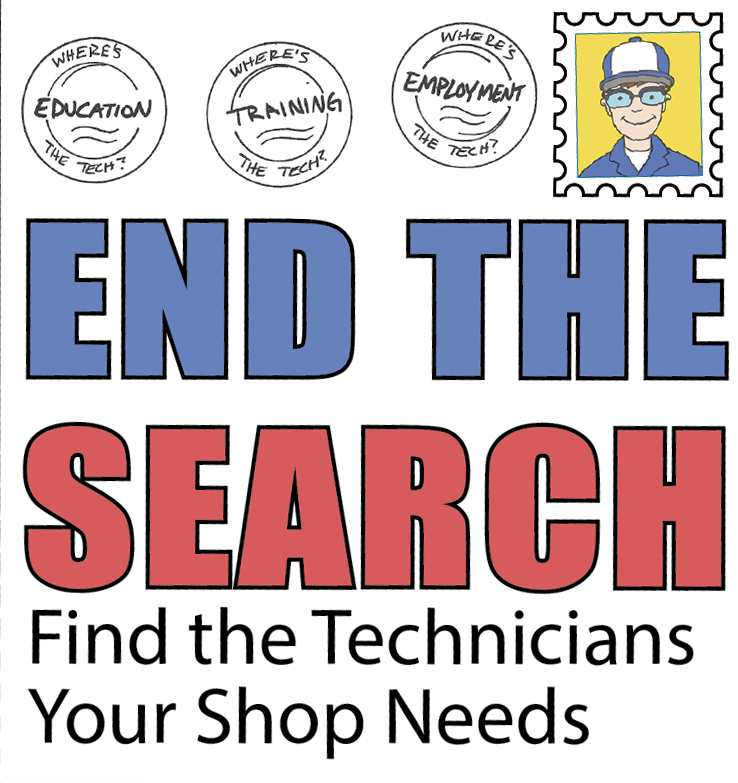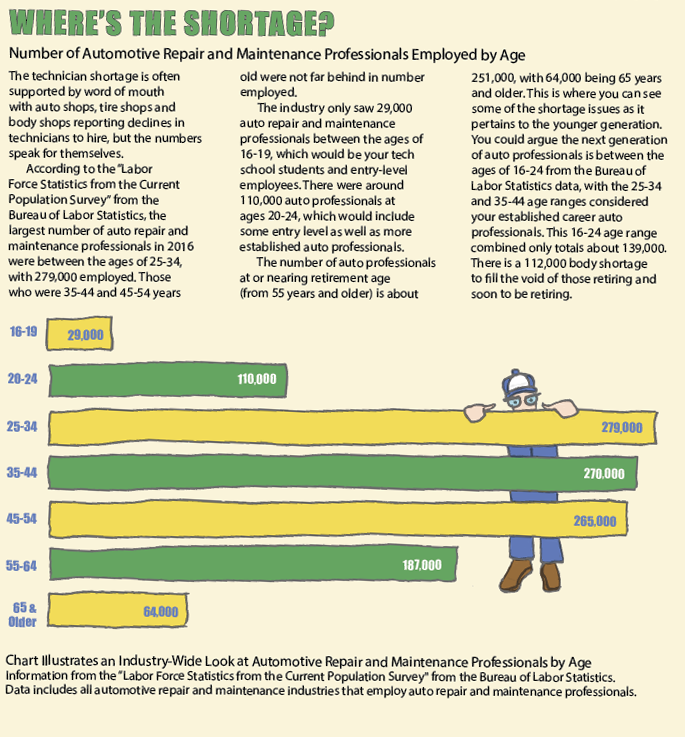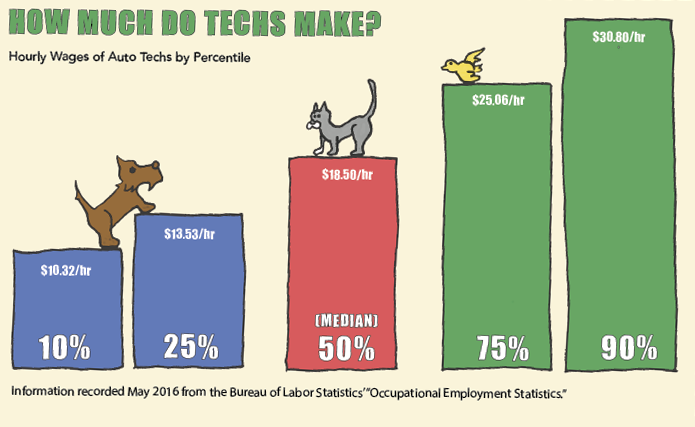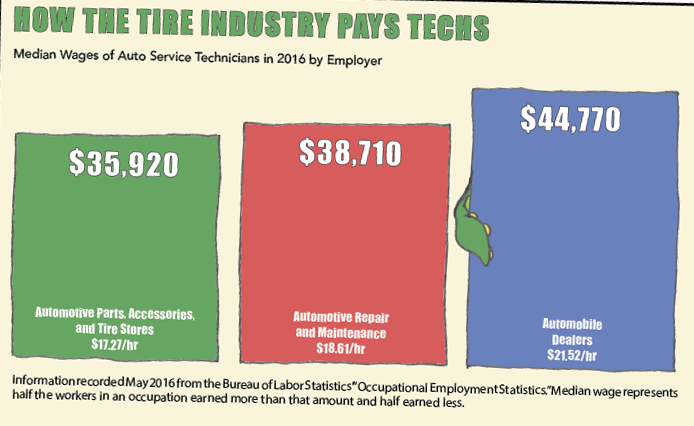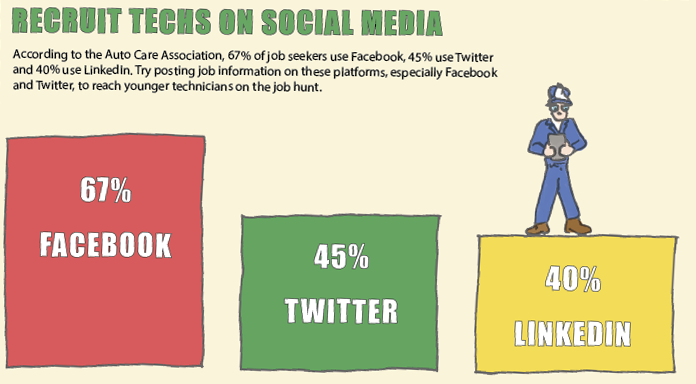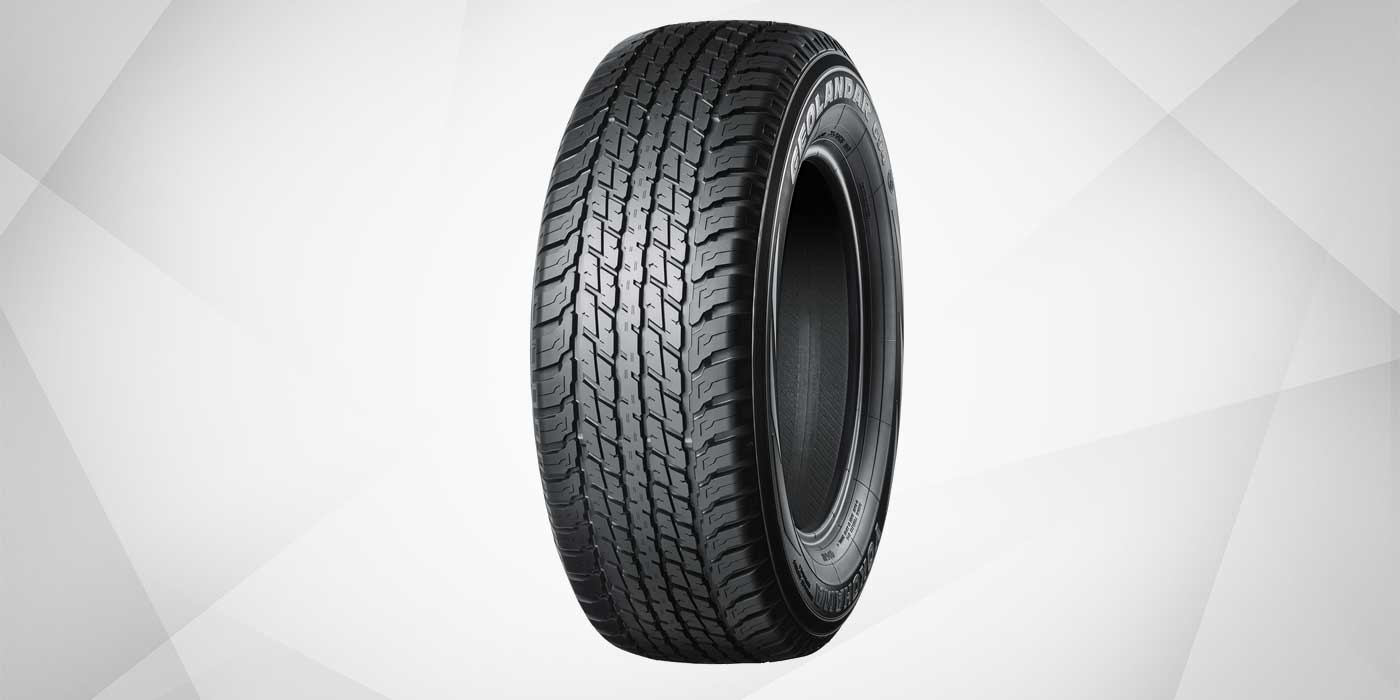Across the country tire dealerships are experiencing empty bays and shops are even closing their doors due to simply not having enough auto repair technicians to get the job done. There are dozen of theories as to why shops can’t find, hire, and keep quality technicians. Some blame the millennial mindset, the aging workforce, and the cultural shift to denounce “dirty” auto jobs. Others attribute the shortage to tech schools not producing quality technicians. But it’s not the why this shortage is happening that is the most important point here. What you should be thinking about is how are you, the independent tire dealer, going to change this problem for your business? How are you going to proactively hire and develop technician talent that will help your business thrive? “Sometimes the most important thing is backing up and getting involved in their community and building some relationships with future techs as they’re growing and maturing rather than just putting all your attention on graduates or people looking for jobs,” says Jennifer Maher, CEO and executive director of TechForce Foundation, a non-profit organization committed to helping tech students with scholarships and grants, and creating tools for employers to hire and train techs. You have the ability to be a part of the change and bring in a new generation of successful technicians, you just have to get involved.
CHANGING PERSPECTIVES
Creating Tech Hopefuls “We are seeing a whole generation of young people who don’t get their driver’s license, and they aren’t even aware of the opportunities. They get in their mother’s car and all they know is how to drive it,” says Trish Serratore, president of the Automotive Youth Education Systems (AYES)/ National Automotive Technicians Education Foundation (NATEF) and senior vice president of ASE. “We still see an awareness issue that [auto care] is a good job with opportunities.” Part of finding the right technicians is creating a pool of technicians to hire, and that all starts with awareness of job opportunities and career growth. There are numerous programs out there advocating and promoting careers in auto care, but what better place to come from than the actual employers. “Getting that awareness down to the actual student to help them understand continues to be difficult. Guidance counselors don’t know. Parents don’t recognize the worth. There’s good job growth and you can make a good living. Communicating that is difficult,” says Serratore. Tire dealers can start by reaching out to local high school auto shop programs, postsecondary education programs, or technical college advisory committees. Many schools are looking for businesses to partner with for internships and training opportunities. Even joining a business-in-education committee is an option.
“[Tire dealers] can concentrate on what they want in students. It then builds that relationship with the instructor so that the business is a student-friendly organization and can call that business and start a job shadowing or internship opportunity. And, it helps businesses get a feel for the class or school…. Building that relationship allows access to students and internships and part-time employment,” Serratore notes.
Give Back
Many tire dealers and their employees are also in a unique position to share their experiences – many of them started out turning a wrench and changing oil themselves. Technical colleges and high schools that still have auto programs are in need of automotive instructors.
“There are adjunct professor jobs where at the high school level, a shop owner comes in and teaches a class,” ASE’s Serratore says. “That would give the main instructor a break and help bring shop owners into the classroom. NATEF and AYES offer a new instructor training guide. It includes six modules to help people understand what to know to be an instructor. It also includes support and materials to help.”
Additional education and training materials are also available from Maher’s organization, TechForce Foundation. The organization is constructing what it calls the “I-Hub,” which will have resources and information on hiring and training technicians from all the organizations across the industry in one easy-to-find place.
“We’ll have all the resources to say it’s not the scary, heavy liability problem that you think it is, and here are the ways that you can offer internships,” Maher explains.
Shops can also look into making contributions in the forms of scholarships or donating tools, equipment and auto parts to help technician students practice repairs.
“They need to be able to have all of that in the high school auto shop because they don’t get any funding from the government anymore, which is what makes it lackluster,” Maher adds.
IN THE SHOP
Training Your Future
Have you already tried to work with technical colleges and haven’t seen any results or feedback? You may have to develop your own talent.
When Mike Davidson, owner at Parkway Automotive in Little Rock, Ark., faced issues with hiring technicians, he decided to solve the problem from within his shop.
“As a shop owner operating a business for 25 years, I’ve been involved at different levels as they come across. I’ve seen the landscape and the difficultly of hiring technicians. I found an advisory board at a technical college and it became clear the school was unable to provide good technicians,” Davidson shares.
Davidson reacted by gathering local shops together and writing curriculum for the tech school that would create the technicians the shops needed. After spending 6-8 months on the curriculum, he and the other shop owners presented the plan to the school’s trustees. When a year or two went by and the curriculum was still shelved, and the shops were still struggling. Davidson took matters into his own hands.
“One shop in Denver was on the verge of losing shops because there were no technicians. I, too, was struggling,” Davidson says. “It’s a reoccurring theme… so my wife asked me, ‘What are you going to do about it?’ I did some discovery and found that the federal government has programs for apprentices. So I began the journey on what it would take to create a program for technicians and be approved by the United States Department of Labor.”
In 2014, Davidson created the American Skilled Labor Association (ASLA), a non-profit organization that offers a comprehensive educational apprenticeship program. The organization not only helps shops find apprentices to train into the technicians they need, it also offers shops reimbursement and connects tire dealers to federal funding available in their area.
ASLA is driven by a mentor approach. Shops who join ASLA register a mentor who is in charge of training and is provided the approved training materials. This is to help the older techs pass down their knowledge to the next generation – something close to Davidson’s heart.
“I grew up without a dad and had no direction of a father figure in my life. My story is the same of hundreds of students from the homes and conditions they are in,” he shares. “We also have these technicians that are saying ‘How am I going to finish well?’ ASLA is the place where our industry can come together so our older generation can help the younger generation and the relationship can grow and won’t be forgotten by either one of them.”
“All the parts are important, but what’s really important is that we have a way for the older generation to pour into the younger generation’s lives and never be forgotten by both of them,” he adds.
The Cost of Keeping Your Techs
Now, maybe you have found a technician and trained them, but you keep losing them to your competition or other industries. Or, you’ve had the “hiring techs” sign up in your shop for way too long and no one is biting at the opportunity. How much you are paying your entry-level techs is probably a factor.
New car dealers are beating you when it comes to paying auto service techs, and it’s probably why they
are leaving your shop to go to the Ford or Toyota dealer down the street.
In May 2016, the Bureau of Labor Statistics recorded that the median annual wage of technicians working for automotive dealers was $44,770. Tire dealers would fall either in the Automotive Repair and Maintenance category or the Automotive Parts, Accessories and Tire Stores category, which paid techs an annual median wage of $38,710 and $35,920, respectively.
Both young and established technicians are leaving the workforce in part because of their wages. An entry-level technician often doesn’t make much more than a state’s minimum wage. The Bureau of Labor Statistics’ 2016 percentile data shows that the overall median wage auto technicians make is about $18.50 an hour, with your lower percentiles making less and your higher percentiles making more. (See graph below).
Average industry data shows that the lowest paid auto techs in the 10th percentile are making $10.32 an hour on average, with those in the 25th percentile making $13.53 an hour. Auto techs considered to be better paid in the 75th percentile are making $25.06 an hour, and the highest paid in the 90th percentile are making $30.80 an hour.
This data shows that many techs are making a sustainable living, but those making $10.32 and $13.53 are not too much above minimum wage in some states. While not explicitly stated in the data, it’s likely these lesser wages are due to experience, which is what your entry-level, younger techs are being paid. Weekly earnings dependent on the amount of work completed must also be taken into consideration. A tech can also be making a low wage due to not enough service work coming through the door.
“We shoot ourselves in the foot because we are one of the lowest paid entry-level employers out there so people – especially millennials, young people – they want what they want now,” TechForce Foundation’s Maher notes. “And even though we are able to come out with research that shows the trajectory over years that you can do very, very well in this industry… we lose them. Part of it is with our pay as we are also competing with different industries.”
Danny Smith, owner of Same Day Tire and Auto Tire Pros in Tulsa, Ok., was experiencing this problem at his five shops and said making an effort to pay techs more upfront has helped him retain more employees.
“Pay more than what they’re worth,” says Smith. “They’re worth it.”
According to Smith, just paying technicians 10% to 20% more can help prevent what he calls the “vicious cycle” of technicians moving from tire dealerships to a series of competitors and car dealerships to make more money, when you could pay them a little more up front to keep them.
“We see it around here every six months to a year,” Smith says. “A tech quits and moves to a car dealer and six months later, they’re back where you are.”
Ask yourself what you can sacrifice in your budget if you aren’t up to paying more for your techs’ salaries or their training.
Technicians are also usually responsible for buying there own tools on the job and/or while in school, shelling out an average of $1,812.15, according to data from Tire Review’s sister publication, Tomorrow’s Tech. Many of these technicians have already spent quite a bit of money for auto tech school and training, so you might consider how you might help your techs buy tools or help with other expenses to help them get started.
Other issues arise from techs paying for school while training on the job. This opens an opportunity to find other ways to help support those promising technician hopefuls before they can get into an internship or full-time work.
“There are ways to have part-time jobs for kids who are going through a technical school and maybe they can’t yet work on cars, but quite frankly they could work at your front desk. That’s a great way for you to have the help of a rising tech that can get to know you and eventually come into their first job with you,” Maher notes.
Audra Fordin, owner of Queens, N.Y.-based Great Bear Auto Repair and Body Shop, has used an entirely new position to help bring more entry-level opportunities to her techs in training.
As the founder and CEO of the Women Auto Know workshops, which educate and empower women about car repair, Fordin recently expanded the program on the dealership side of customer education with the Person-to-Person Advisor (PPA) training program.
The PPA program not only helps shops and their technicians learn better communication and customer service skills, but it can also be leveraged into a position in itself. Similar to a service advisor, Fordin suggests shops can use a PPA-certified tech hopeful unable to start interning or working on vehicles as an entry-level position to get them in the door.
“It’s an entry-level opportunity where you will be able to provide a great need that the shop has – that need is customer service,” Fordin says. “As a young person you’re a liability more than anything. I try to shadow you, do my own training, but this way your entry level can be dual purpose. You can look out for customer service and your customers’ needs are taken care of and your customer service needs are taken care of.”
Taking control of what you can do to end the tech shortage and solve its inherit issues will bring you one step closer to filling those technician positions and growing the next generation of techs. You can’t sit around and wait for the storm to pass.
“At the end of the day, this is such a big problem. When industry starts to talk about a tsunami coming, there is a reason they are using the word tsunami,” says TechForce Foundation’s Maher. “And it’s not going to be fixed by a couple of big guys writing checks and running ads on TV; it’s going to be a grassroots movement that takes everybody in industry.”


